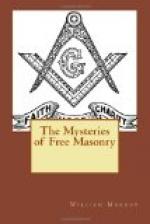Q. Was there anything particular took place on the discovery of the body? A. There was, viz.: On removing the earth till they came to the coffin, they involuntarily found their hands raised in this position to guard their nostrils against the offensive effluvia that ’rose from the grave.
Q. How long had the body lain there? A. Fourteen days.
Q. What did they do with the body? A. Raised it in a Masonic form, and carried it up to the Temple for more decent interment.
Q. Where was it buried? A. Under the sanctum sanctorum, or holy of holies, of King Solomon’s Temple, over which they erected a marble monument, with this inscription delineated thereon: A virgin weeping over a broken column, with a book open before her; in her right hand a sprig of cassia; in her left, an urn; Time standing behind her, with his hands infolded in the ringlets of her hair.
Q. What do they denote? A. The weeping virgin denotes the unfinished state of the Temple; the broken column, that one of the principal supporters of Masonry had fallen; the open book before her, that his memory was on perpetual record; the sprig of cassia, the timely discovery of his grave; the urn in her left hand, that his ashes were safely deposited under the sanctum sanctorum, or holy of holies, of King Solomon’s Temple; and Time standing behind her, with his hands infolded in the ringlets of her hair, that time, patience, and perseverance will accomplish all things.
* * * * *
THIRD SECTION.
Question—What does a Master’s Lodge represent? Answer—The sanctum sanctorum, or holy of holies, of King Solomon’s Temple.
Q. How long was the Temple building? A. Seven years; during which it rained not in the daytime, that the workmen might not be obstructed in their labor.
Q. What supported the Temple? A. Fourteen hundred and fifty-three columns, and two thousand, nine hundred and six pilasters, all hewn from the finest Parian marble.
Q. What further supported it? A. Three grand columns, or pillars.
Q. What were they called? A. Wisdom, Strength, and Beauty.
Q. What did they represent? A. The pillar of Wisdom represented Solomon, King of Israel, whose wisdom contrived the mighty fabric; the pillar of Strength, Hiram, King of Tyre, who strengthened Solomon in his glorious undertaking; the pillar of Beauty, Hiram Abiff, the widow’s son, whose cunning craft and curious workmanship beautified and adorned the Temple.
Q. How many were there employed in the building of King Solomon’s Temple? A. Three Grand Masters; three thousand, three hundred Masters, or overseers of the work; eighty thousand Fellow Crafts, and seventy thousand Entered Apprentices; all those were classed and arranged in such a manner, by the wisdom of Solomon, that neither envy, discord, nor confusion were suffered to interrupt that universal peace and tranquility that pervaded the work at that important period.




